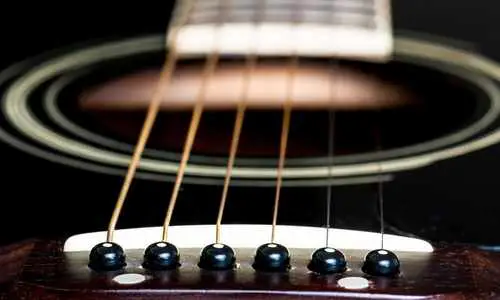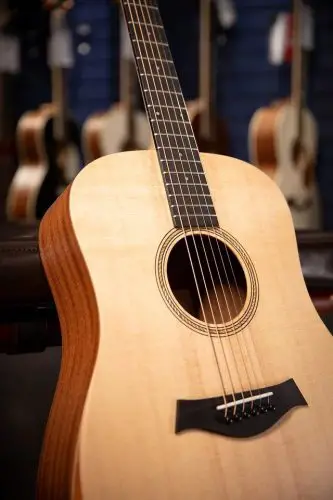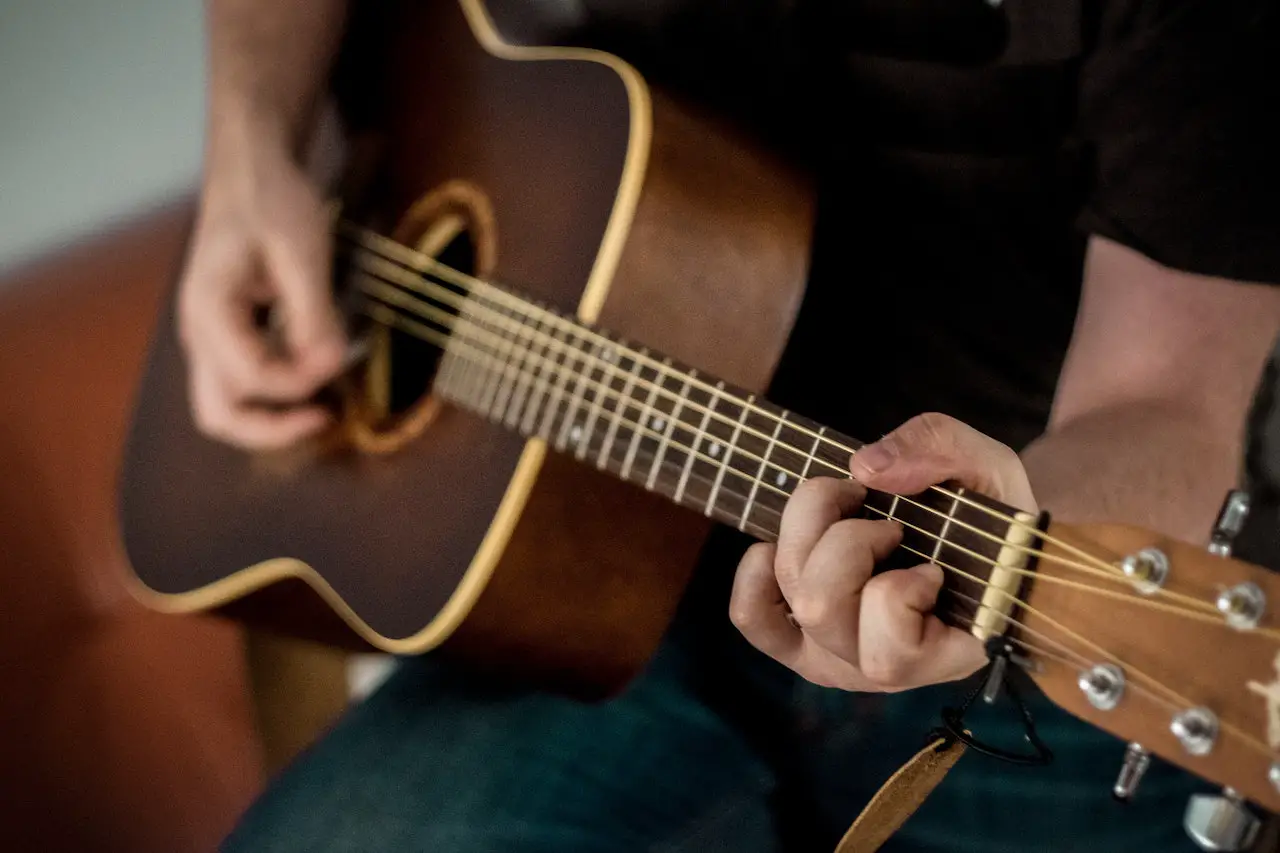The best string gauge for fingerstyle guitar playing depends on personal preference and playing style. Generally, lighter gauge strings are favored by fingerstyle players as they offer easier fretting and bending. Commonly string gauges used for fingerstyle range from 0.011 to 0.013 for the treble strings, and 0.052 to 0.056 for the bass strings.
Lighter gauge strings allow for greater control and precision when playing intricate fingerstyle patterns. They also produce a brighter, more articulate tone that accentuates the nuances of fingerpicked notes. However, lighter gauge strings may sacrifice some volume and bass response compared to heavier gauges.
On the other hand, heavier gauge strings offer a fuller, more resonant sound with enhanced bass and volume. They can provide more sustain and a richer tone, which is particularly desirable for fingerstyle players who prefer a deep, bass-heavy sound. However, heavier gauge strings require more finger strength and may be less forgiving when it comes to intricate fingerstyle techniques.
It is important to note that individual playing style, finger strength, and guitar setup can also greatly impact the string gauge preference. Experimenting with different gauges is the best way to find the right fit for your playing style and desired tone. Some fingerstyle players may prefer a mix of heavier gauge bass strings for increased volume and lighter gauge treble strings for improved playability.
Moreover, the choice of string material can also affect the overall sound and feel. Nickel-plated steel strings offer a balanced tone with a smooth feel, while phosphor bronze strings produce a warmer, more vintage-inspired sound.
Coated strings, such as those with a polymer coating, can enhance string longevity and decrease finger noise. Ultimately, finding the best string gauge for fingerstyle playing involves a combination of personal preference, experimentation, and understanding the characteristics of different string materials. So, don’t be afraid to try out different gauges until you find the perfect match for your fingerstyle guitar playing.
In my personal experience, I have found that using a lighter gauge string, such as .011s or .012s, allows for easier finger movement and greater control when playing fingerstyle. These lighter gauge strings also provide a brighter, more articulate tone that brings out the nuances of fingerpicked notes.
However, I have also experimented with heavier gauge strings, such as .013s or .014s, for a fuller, more resonant sound with enhanced bass and volume. While heavier gauge strings require more finger strength and may not be as forgiving for intricate fingerstyle techniques, they can add depth and richness to the overall sound.
Ultimately, finding the best string gauge for fingerstyle playing comes down to personal preference and experimentation. Let’s dive into more details now.
Here’s a summary table for you busy musicians:
| String Gauge / Material | Pros | Cons |
|---|---|---|
| Lighter Gauge | – Easier fretting and bending – Brighter and more articulate tone – Greater control and precision |
– Sacrifice some volume and bass response – Requires more finger strength for heavy playing |
| Heavier Gauge | – Fuller and more resonant sound – Increased bass response and volume – Enhanced sustain and projection |
– Requires more finger strength – Less forgiving for intricate techniques – Increased risk of string breakage |
| Phosphor Bronze | – Warm and balanced tone – Excellent sustain and projection |
– Longer break-in period |
| 80/20 Bronze | – Bright and vibrant tone – Quicker break-in period |
– Less warmth and depth compared to phosphor bronze |
| Nickel-plated Steel | – Balanced and versatile tone – Smooth feel and clarity |
– None significant |
| Silk and Steel | – Softer and mellower tone – Easier on the fingers |
– Reduced brightness and projection |
| Nylon | – Soft and smooth feel – Comfortable playing experience – Warm and mellow tone |
– Less brightness and projection compared to steel strings |
What are the pros and cons of lighter gauge strings for fingerstyle playing?

Light gauge string is easier to play but the tone is not as rich
Pros:
- Easier fretting and bending, facilitating intricate fingerstyle patterns.
- Produces a brighter and more articulate tone, allowing better expression of nuances.
- Increased responsiveness and sensitivity for greater control and dynamic range.
Cons:
- May sacrifice volume and bass response compared to heavier gauge strings.
- Requires more precision and finger strength for optimal tone and volume.
- More prone to breakage, especially with aggressive playing styles.
In my personal experience, using lighter gauge strings for fingerstyle playing has been beneficial in many ways. The ease of fretting and bending allows for fluid movement across the fretboard, enabling faster and more intricate fingerstyle techniques. The brighter tone also enhances the clarity and articulation of individual notes, which is essential for fingerstyle arrangements and melodies.
However, I have noticed that using lighter gauge strings may require some adjustments to my playing style. The lack of low-end resonance and volume can be compensated with proper EQ settings on an amplifier or through specific fingerpicking techniques to maximize the tonal characteristics of the lighter strings. Additionally, being mindful of string tension and taking precautions to prevent breakage is crucial to maintaining the longevity and playability of the lighter gauge strings.
It is important to note that personal preference and playing style play a significant role in determining the suitability of different string gauges. While lighter gauge strings may offer certain benefits for fingerstyle playing, each guitarist should experiment and decide what works best for their individual playing style, tone preferences, and finger strength.
Also Read: Beginner’s Guide: The Easiest String Gauge for Your Guitar
What are the benefits of using heavier gauge strings for fingerstyle playing?

Heavy gauge strings produce richer tone but harder to play
Pros:
- Fuller and richer tone with enhanced bass response.
- Increased sustain for creating lush arrangements.
- More volume and projection, ideal for larger venues.
- Improved durability, less prone to breaking with aggressive playing styles.
Cons:
- Harder on fingers and requires more finger strength for fretting.
- Reduced ease of bending and executing intricate fingerstyle patterns.
- Potential strain on the guitar’s neck and bridge due to higher tension.
- Can be less responsive to lighter touches, affecting dynamic control.
In my personal experience, using heavier gauge strings for fingerstyle playing has allowed me to achieve a fuller and more resonant tone. The increased bass response and sustain have added depth and richness to my fingerstyle arrangements. Additionally, the added volume and projection have made my playing more impactful in live performances and jam sessions.
However, it’s worth noting that heavier gauge strings may not be suitable for all fingerstyle players. The additional finger strength required to fret and bend the thicker strings can be challenging for some, especially those who are just starting or have weaker fingers. It’s crucial to find a balance between playability and desired tone to ensure a comfortable playing experience.
Also Read: String Gauge Influence on Guitar Sound: Lighter vs. Heavier
What are the different string materials used for fingerstyle playing?

Bronze guitar string
There are various string materials that can be used for fingerstyle playing, each offering a unique tone and feel. Some common string materials used for fingerstyle guitar include:
1. Phosphor Bronze: Phosphor bronze strings are known for their warm and balanced tone. They offer a rich and resonant sound, making them a popular choice for fingerstyle players seeking a vintage-inspired tone. These strings have a slightly longer break-in period but provide excellent sustain and projection.
2. 80/20 Bronze: 80/20 bronze strings, also known as bronze strings, are bright and vibrant, delivering a crisp and articulate tone. They have a quicker break-in period compared to phosphor bronze strings, making them ideal for players who want an immediate bright tone. However, they may not offer as much warmth or depth as phosphor bronze strings.
3. Nickel-plated Steel: Nickel-plated steel strings produce a well-balanced and versatile tone. They offer a smooth feel and clarity, emphasizing the midrange frequencies. Fingerstyle players who prefer a bright and articulate sound with a smooth touch often opt for nickel-plated steel strings.
4. Silk and Steel: Silk and steel strings combine a traditional steel core with silk wraps around the winding, resulting in a softer and mellower tone. These strings are generally easier on the fingers and may be preferred by fingerstyle players looking for a more gentle and subdued sound.
5. Nylon: Nylon strings are commonly used on classical guitars and offer a warm and mellow tone. They have a softer feel and are easier on the fingers, making them suitable for players who prioritize comfort and a softer touch. While not as commonly used for fingerstyle playing on steel-string guitars, some fingerstyle players may experiment with nylon strings for a unique sound.
In my own experience, I have found that phosphor bronze strings offer a warm and balanced tone that works well for fingerstyle playing. The rich resonance and sustain of these strings bring out the nuances of fingerpicked notes and complement the dynamic range of fingerstyle techniques.
However, I have also enjoyed the bright and articulate sound of nickel-plated steel strings, particularly for more percussive and energetic fingerstyle playing. Ultimately, the choice of string material for fingerstyle playing is subjective and should be based on personal preference and desired tone.
Also Read: String Brand’s Impact on Tone: Unraveling the Secrets
How often should I change my strings for fingerstyle playing?
The frequency of string changes for fingerstyle playing depends on several factors, including playing frequency, playing style, and personal preference. Generally, it is recommended to change your strings every 1-3 months for optimal performance and tone.
Fingerstyle playing tends to be less aggressive compared to strumming or heavy picking, resulting in slower string wear. However, it’s important to note that fingerstyle playing still puts stress on the strings, especially if you use a lot of bends or play with a strong attack. Over time, strings can lose their brightness, become dull, and develop uneven tone or intonation.
Some signs that indicate it may be time to change your strings include:
1. Loss of brightness: Strings gradually lose their initial brightness and become duller over time. If you notice a significant reduction in high-end frequencies and a lack of clarity, it may be a sign that your strings need to be replaced.
2. Audible buzzing or dead spots: As strings wear out, they may develop dead spots where certain notes don’t resonate well, resulting in buzzing or uneven volume. This is particularly noticeable in fingerstyle playing, where each note is crucial for clarity and articulation.
3. Difficulty staying in tune: Worn-out strings can have a harder time staying in tune due to decreased tension stability. If you find yourself frequently needing to retune your guitar, it may be an indication that it’s time for new strings.
4. Visible signs of wear: Physical signs of wear, such as rusty or discolored strings, fraying or unraveling winding, or visible dirt buildup, are clear indicators that your strings have reached the end of their lifespan.
It’s also important to consider personal preference when deciding when to change your strings. Some players may prefer the tone and feel of slightly aged strings, while others prefer the bright and crisp sound of fresh strings. Experimenting with different string ages can help you find your ideal balance between tonal quality and playability.
In my own experience as a fingerstyle player, I typically change my strings every 2-3 months. This allows me to maintain a consistent tone and feel while avoiding any significant degradation in sound quality. However, this timeframe can vary depending on how often I practice and perform. If I have an upcoming gig or recording session, I may opt to change my strings a bit earlier to ensure peak performance.
Conclusion: Are heavy or light strings better for fingerpicking?
When it comes to fingerpicking, the choice between heavy or light strings ultimately depends on personal preference and playing style. Both heavy and light strings have their own advantages and considerations.
Lighter gauge strings are generally favored by fingerstyle players for their ease of fretting and bending. They offer a lighter touch and require less finger strength, making it easier to execute intricate fingerpicking patterns with precision. This is particularly beneficial for players who prioritize speed and agility in their fingerpicking technique. Lighter gauge strings also tend to produce a brighter and more articulate tone, which can enhance the clarity and definition of individual notes in fingerstyle arrangements.
On the other hand, heavy gauge strings can provide a more robust and resonant sound. They offer enhanced volume, bass response, and sustain, which can be desirable for fingerstyle players aiming for a fuller and more powerful sound.
Heavy strings can add depth and richness to fingerpicked melodies and chord progressions, creating a stronger presence, especially in live performances or larger venues. However, heavy gauge strings require more finger strength and may be less forgiving when it comes to intricate fingerstyle techniques.
It’s important to consider your playing style and physical capabilities when choosing between heavy and light strings for fingerpicking. If you have a lighter touch and prefer a brighter tone with ease of playability, lighter gauge strings may be the better choice.
They can accommodate fast and intricate fingerpicking patterns while still offering a clear and articulate tone. On the other hand, if you prioritize volume, bass response, and a fuller sound, heavy gauge strings may be more suitable. However, it’s worth noting that heavy gauge strings can be more physically demanding and may require more finger strength to achieve optimal tone and control.
Ultimately, it’s a matter of finding the right balance between playability and tone. Some fingerstyle players may prefer a mix of heavy gauge bass strings for increased volume and projection, paired with lighter gauge treble strings for enhanced playability and brightness. It’s recommended to try out different string gauges and see which combination suits your playing style and desired sound best.
Also Asked: What strings are easiest on fingers?
When it comes to fingerpicking, nylon strings are often considered the easiest on the fingers. Nylon strings have a soft and smooth texture, which provides a more comfortable playing experience, especially for players with sensitive fingertips or those who are just starting out. The suppleness of nylon strings reduces the amount of pressure and friction exerted on the fingers, resulting in less discomfort or soreness during prolonged playing sessions.
Nylon strings are commonly used on classical guitars, where the focus is on achieving a warm and mellow tone. The softer feel of nylon strings also makes it easier for players to execute techniques such as classical fingerpicking or intricate fingerstyle patterns with greater ease and finesse. The flexibility of nylon strings allows for smoother transitions between notes and facilitates more fluid movements across the fretboard.
In addition to nylon, some brands offer silk and steel strings as another option for fingerpicking. Silk and steel strings combine a traditional steel core with silk wraps around the winding. This combination provides a gentler feel and a mellower tone compared to other string materials. Silk and steel strings can be particularly suitable for players seeking a more delicate and subdued sound, or those who prefer a lighter touch and reduced finger fatigue during extended playing sessions.
It’s worth noting that while nylon and silk and steel strings offer a more forgiving playing experience, they may not produce the same brightness or projection as steel strings. The tonal characteristics of these strings are often associated with a softer, more rounded sound. Therefore, the choice between nylon, silk and steel, or steel strings ultimately depends on personal preference and the desired tone for your fingerpicking style.
Summary
In conclusion, finding the best string gauge for fingerstyle playing is a matter of personal preference, playing style, and desired tone. Lighter gauge strings offer ease of playability and a brighter tone, which accentuates the nuances of fingerpicked notes. On the other hand, heavier gauge strings provide a fuller sound with increased bass response and volume. It’s important to experiment with different string gauges to find the perfect balance between playability and desired tone.
In addition, considering the string material is crucial. Phosphor bronze, 80/20 bronze, nickel-plated steel, silk and steel, and nylon each offer their own unique characteristics in terms of tone and feel. Exploring these options can help you discover the perfect sound and playing experience for your fingerstyle guitar playing.
Whether you prefer the delicate touch of nylon, the warmth of phosphor bronze, or the power of heavier gauge strings, the choice is ultimately yours. So, grab your guitar and embark on a journey to find the perfect strings that will make your fingerstyle playing shine!






